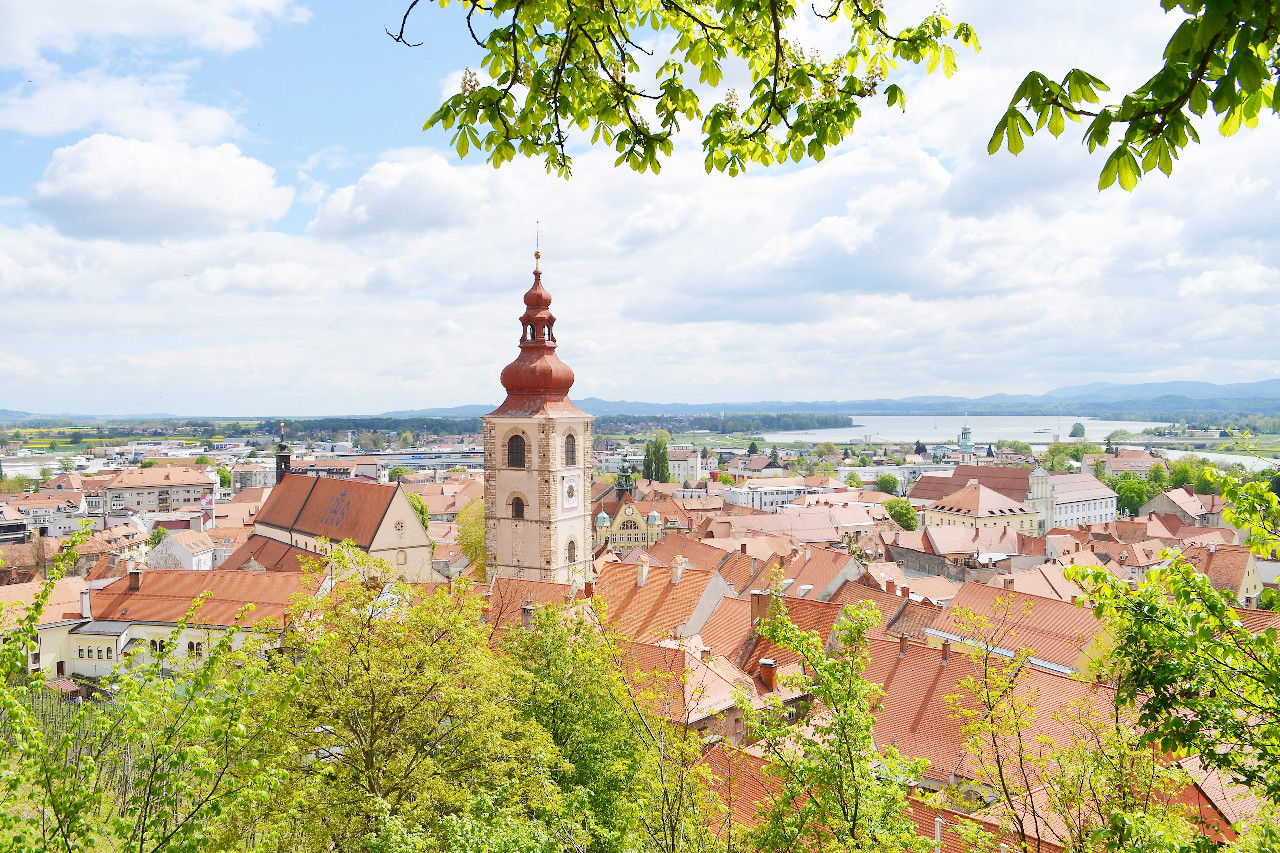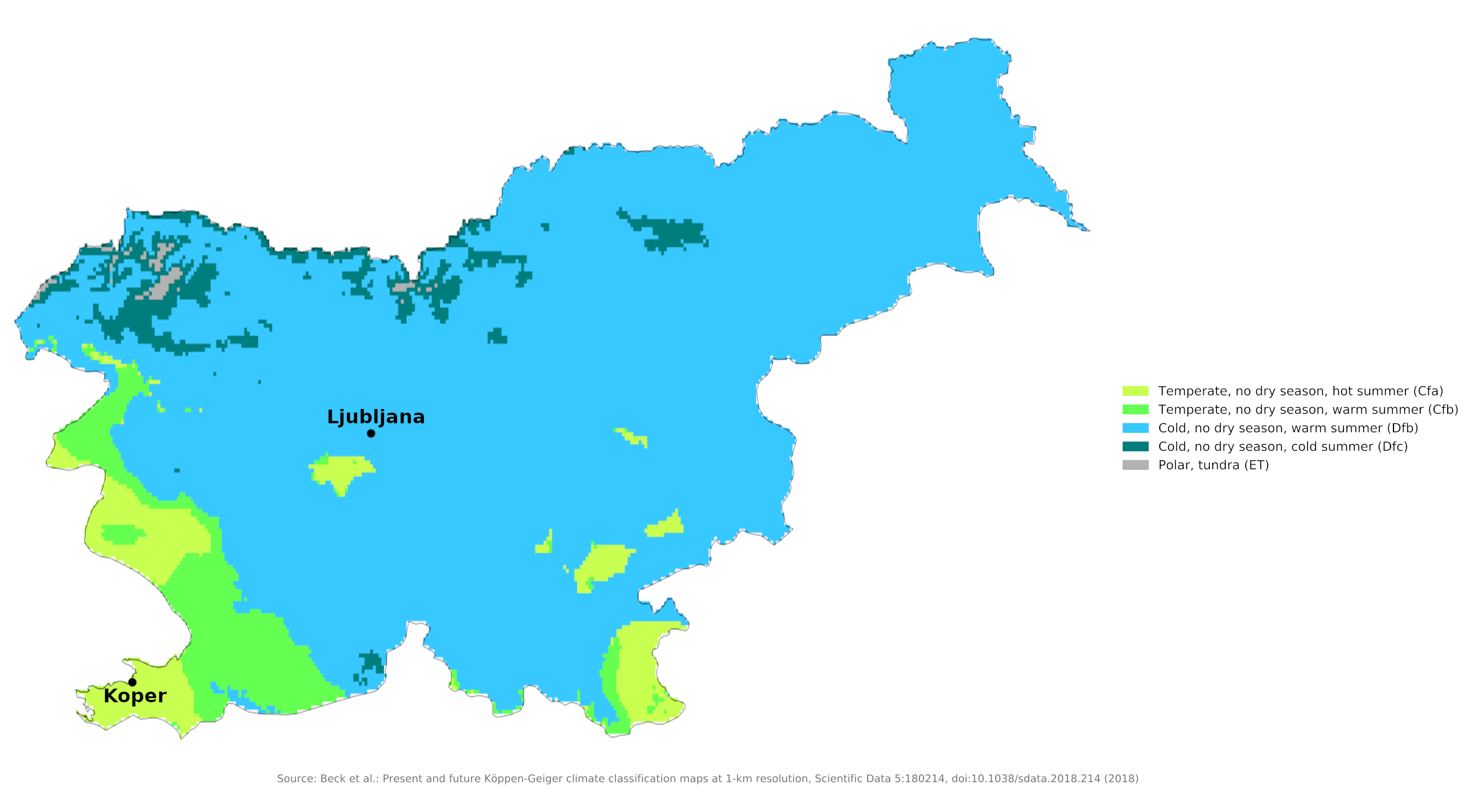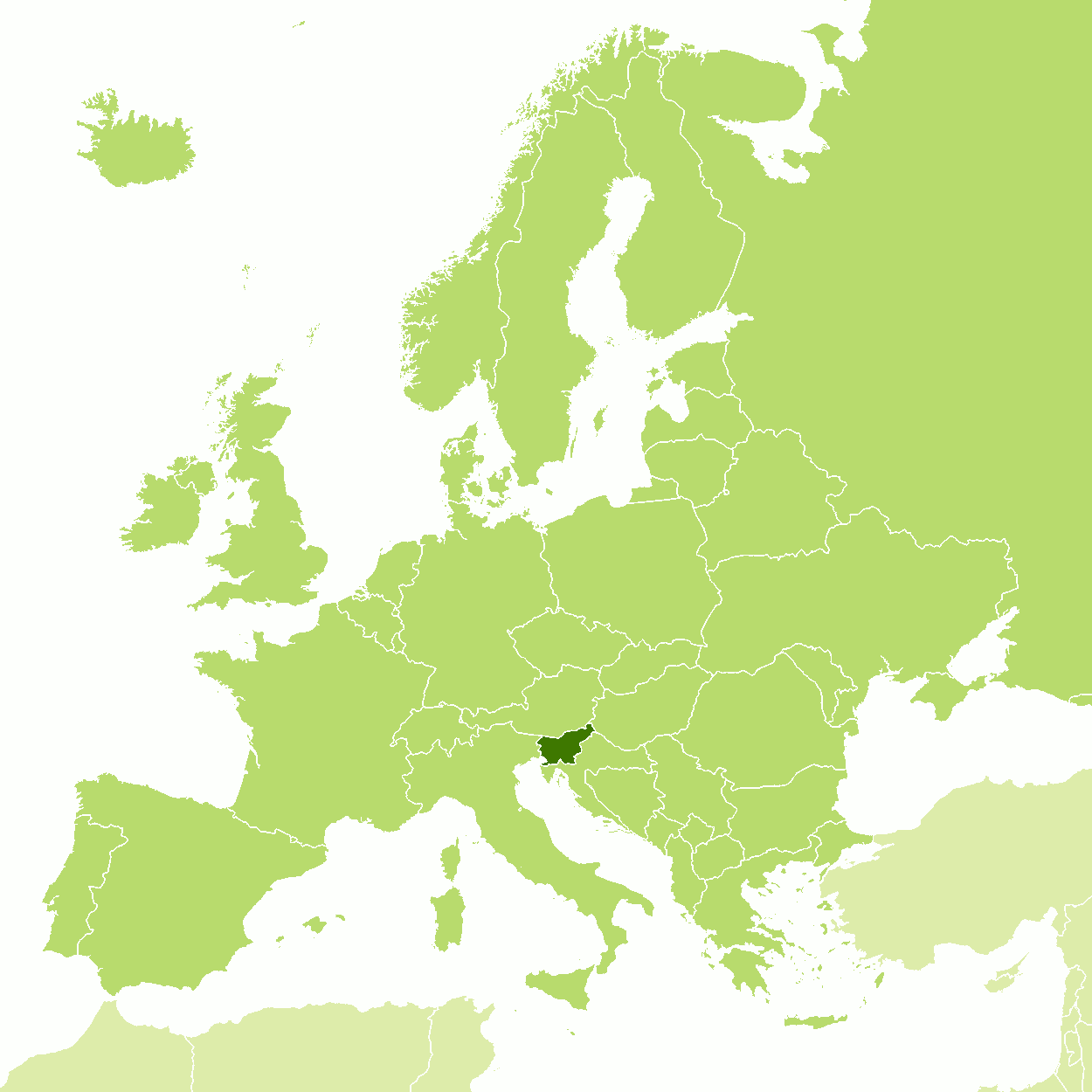The Climate of
Slovenia
 View over the city of Ptuj
View over the city of Ptuj
Climate Map
 Climate map of Slovenia
Climate map of Slovenia
What is the climate of Slovenia like?
Slovenia is located in central Europe. It shares boundaries with Austria (north), Hungary (east), Croatia (south), and the Adriatic Sea and Italy (west).
Slovenia’s coastal climate is influenced by the Mediterranean Sea. Although this is only a small part of Slovenia, it is the best-known and most visited part of the country. This region has a Mediterranean type of climate with mild winters and warm, sunny summers. The average January and July temperatures in Koper, the largest coastal city, are 6°C (42°F) and 24°C (74°F), respectively. Rainfall averages around 1000 millimeters (40 Inches) each year.
The interior climate of Slovenia is more continental with mild to hot summers, and cold winters in the plateaus and valleys to the east. The average January and July temperatures in Ljubljana, the Slovenian capital, are 0°C (32°F) and 21°C (70°F) respectively. Each year, Ljubljana experiences about 90 days that are colder than 0°C (32°F) and about 61 days that are hotter than 25°C (77°F). Ljubljana receives about 1400 millimeters (55 inches) of rain each year, with 28 percent of the total occurring between April and June. Slovenia also includes part of the eastern Alps, with weather and climate very similar to southern Austria.
The one unpleasant feature of the winter weather is a cold gusty wind, the bora, which brings cold air from central and eastern Europe down to the coast for a few days at a time; it blows particularly violently in Slovenia. Summers on this coast are not entirely rainless, and the fine, sunny weather is often interrupted by thunderstorms. Sunshine averages some four hours a day in winter and from ten to twelve hours a day in summer.
The Slovenian capital Ljubljana illustrates conditions at moderate inland elevations. Koper represents condition on the coast.
| Climate data for Ljubljana | |||||||||||||
|---|---|---|---|---|---|---|---|---|---|---|---|---|---|
| Month | Jan | Feb | Mar | Apr | May | Jun | Jul | Aug | Sep | Oct | Nov | Dec | Year |
| Average high °C (°F) | 3.4 (38.1) | 6.4 (43.5) | 11.4 (52.5) | 16.1 (61.0) | 21.4 (70.5) | 24.6 (76.3) | 27.3 (81.1) | 26.7 (80.1) | 21.6 (70.9) | 15.9 (60.6) | 8.8 (47.8) | 3.8 (38.8) | 15.6 (60.1) |
| Daily mean °C (°F) | 0.3 (32.5) | 1.9 (35.4) | 6.5 (43.7) | 10.8 (51.4) | 15.8 (60.4) | 19.1 (66.4) | 21.3 (70.3) | 20.6 (69.1) | 16.0 (60.8) | 11.2 (52.2) | 5.6 (42.1) | 1.2 (34.2) | 10.9 (51.6) |
| Average low °C (°F) | −2.5 (27.5) | −2.0 (28.4) | 1.7 (35.1) | 5.8 (42.4) | 10.3 (50.5) | 13.7 (56.7) | 15.5 (59.9) | 15.2 (59.4) | 11.5 (52.7) | 7.7 (45.9) | 2.8 (37.0) | −1.1 (30.0) | 6.6 (43.9) |
| Average precipitation mm (inches) | 69 (2.7) | 70 (2.8) | 88 (3.5) | 99 (3.9) | 109 (4.3) | 144 (5.7) | 115 (4.5) | 137 (5.4) | 147 (5.8) | 147 (5.8) | 129 (5.1) | 107 (4.2) | 1,362 (53.6) |
| Source: Slovenian Environment Agency (ARSO) | |||||||||||||
| Climate data for Koper | |||||||||||||
|---|---|---|---|---|---|---|---|---|---|---|---|---|---|
| Month | Jan | Feb | Mar | Apr | May | Jun | Jul | Aug | Sep | Oct | Nov | Dec | Year |
| Average high °C (°F) | 7.8 (46.0) | 9.2 (48.6) | 12.6 (54.7) | 16.7 (62.1) | 21.5 (70.7) | 25.0 (77.0) | 27.5 (81.5) | 27.1 (80.8) | 23.4 (74.1) | 18.6 (65.5) | 13.1 (55.6) | 9.4 (48.9) | 17.7 (63.9) |
| Daily mean °C (°F) | 5.6 (42.1) | 6.5 (43.7) | 9.3 (48.7) | 12.9 (55.2) | 17.4 (63.3) | 21.1 (70.0) | 23.5 (74.3) | 23.3 (73.9) | 19.9 (67.8) | 15.5 (59.9) | 10.4 (50.7) | 7.1 (44.8) | 14.4 (57.9) |
| Average low °C (°F) | 3.5 (38.3) | 3.9 (39.0) | 6.0 (42.8) | 9.2 (48.6) | 13.4 (56.1) | 17.2 (63.0) | 19.6 (67.3) | 19.5 (67.1) | 16.4 (61.5) | 12.4 (54.3) | 7.7 (45.9) | 4.8 (40.6) | 11.1 (52.0) |
| Average precipitation mm (inches) | 75 (3.0) | 70 (2.8) | 72 (2.8) | 89 (3.5) | 82 (3.2) | 92 (3.6) | 69 (2.7) | 93 (3.7) | 111 (4.4) | 98 (3.9) | 117 (4.6) | 88 (3.5) | 1,056 (41.6) |
| Source: Climate-Data.org | |||||||||||||
References
- E. A. Pearce, Charles Gordon Smith, (1990) The Hutchinson World Weather Guide, John Murray Press. ISBN 1859863426
- Timothy L. Gall, (ed.), (2003), Worldmark Encyclopedia of the Nations, Eleventh Edition, Thomson Gale
- Hugh Chisholm, (ed.), (1911), Encyclopædia Britannica, Eleventh edition, Cambridge University Press
When is the best time to visit Slovenia?
Slovenia is warm near the coast, cooler in the interior. April–October is best for warm weather, December–April for winter sports.
The Climate of
Slovenia

In summary:
Slovenia's climate ranges from a Mediterranean one on the coast, to a moderately continental climate inland, and alpine in the highest mountains. It generally has mild to hot summers. In Ljubljana, July's mean temperature is 21°C (70°F). The coast has mild winters, whereas the plateaus and valleys to the east have cold winters. Rainfall in the capital averages 1400 mm (55 in) a year.